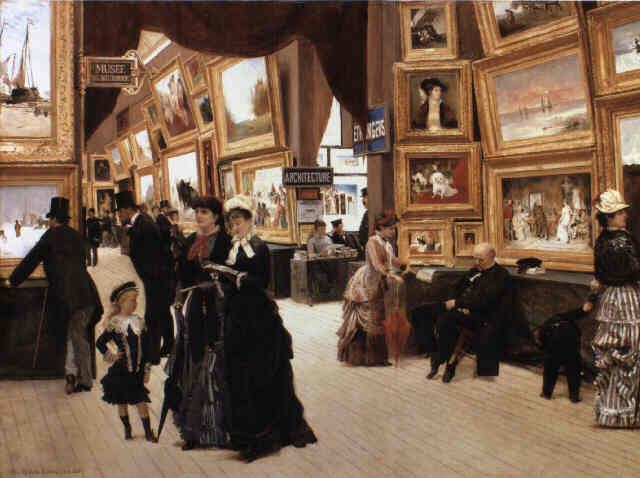The Salon was (and is) a magical concept in art. Reputations were made and broken here, especially when Paris was the cultural capital of Europe. The first salon, l'exposition, took place in 1648 and from 1833 onwards this exhibition of (new) artists took place annually, with entire walls covered with approved works. Initially, the salon was for students of the French Academy. From 1881 onwards, the organization is fully in the hands of the Société des Artistes Français and anyone can submit work. Then the salon really takes off. The number of works from which the jury must select increases drastically; usually only half get a place and therefore the opportunity to be bought. Artists who work in the academic style are often given preference over less traditional work by, for example, the Impressionists.

Édouard Joseph Dantan-Au coin du salon-1880
It was absolutely necessary for visual artists who wanted to establish their name to participate. Not infrequently, bribes were also paid. Yet the image of the salon as a conservative stronghold is not entirely justified. Romanticism and realism were able to break through precisely thanks to the annual exhibition. And later, thanks to the refusal for the salon, also impressionism.

Delacroix Dante's boat
Delacroix saw how important success at the salon could be for your career. He himself made his debut at the Salon in 1821 with 'Dante's Boat'. The painting was immediately purchased by the state and this happened very often, causing his works to hang prominently in museums in France. But not all his paintings were admitted to the salon. Vincent van Gogh wrote in 1885 that he often thought of Delacroix when things went wrong again. “17 of his paintings were rejected [at the salon]”. Newcomers who went their own way, such as Paul Cézanne, were often rejected. The rejected work was marked with a stamp with the letter R (for "refusé") and that made it more difficult to sell.
But even if the work had been selected, it was still important to get a good place. In the nineteenth century, the entire wall was covered with paintings during an exhibition. Of course, if the work was hung very high, no one could see it. Through letters and requests to the academy's management, the artists tried to get a better place.
The Salon des Refusés was the first exhibition held in parallel to the official Paris salon in 1863 on the initiative of Napoleon III. Édouard Manet showed his (censored) Le déjeuner sur l'herbe there and the art world changed forever. Other participants in the various Salons des Refusés were James McNeill Whistler (with The White Girl), Alfred Sisley, Renoir, Henri Fantin-Latour, Paul Cézanne, Armand Guillaumin, Johan Barthold Jongkind and Camille Pissarro.

James McNeill Whistler- The white girl
